

Felipe Cavalcante
Algo do que fica
Brasilia, Editora Sem/Registro, 2013
13,7 x 9 cm.
[96] p.
https://felipecavalcante.com/algo-do-que-fica



Felipe Cavalcante
Algo do que fica
Brasilia, Editora Sem/Registro, 2013
13,7 x 9 cm.
[96] p.
https://felipecavalcante.com/algo-do-que-fica
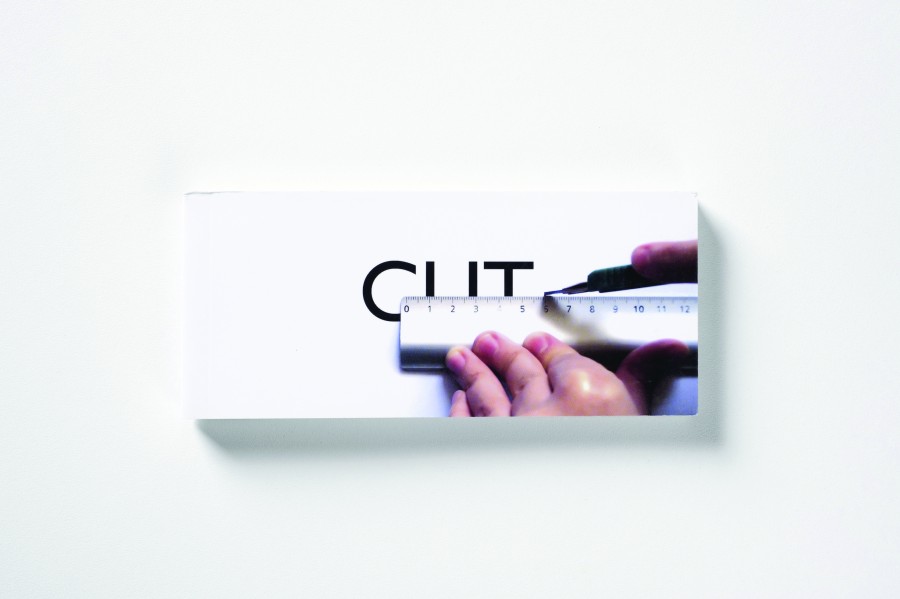
Marie Bocquet
CUT
Rennes, Lendroit , 2009
6,5 x 15 cm
96 p.
ISBN 978-2-917427-12-5
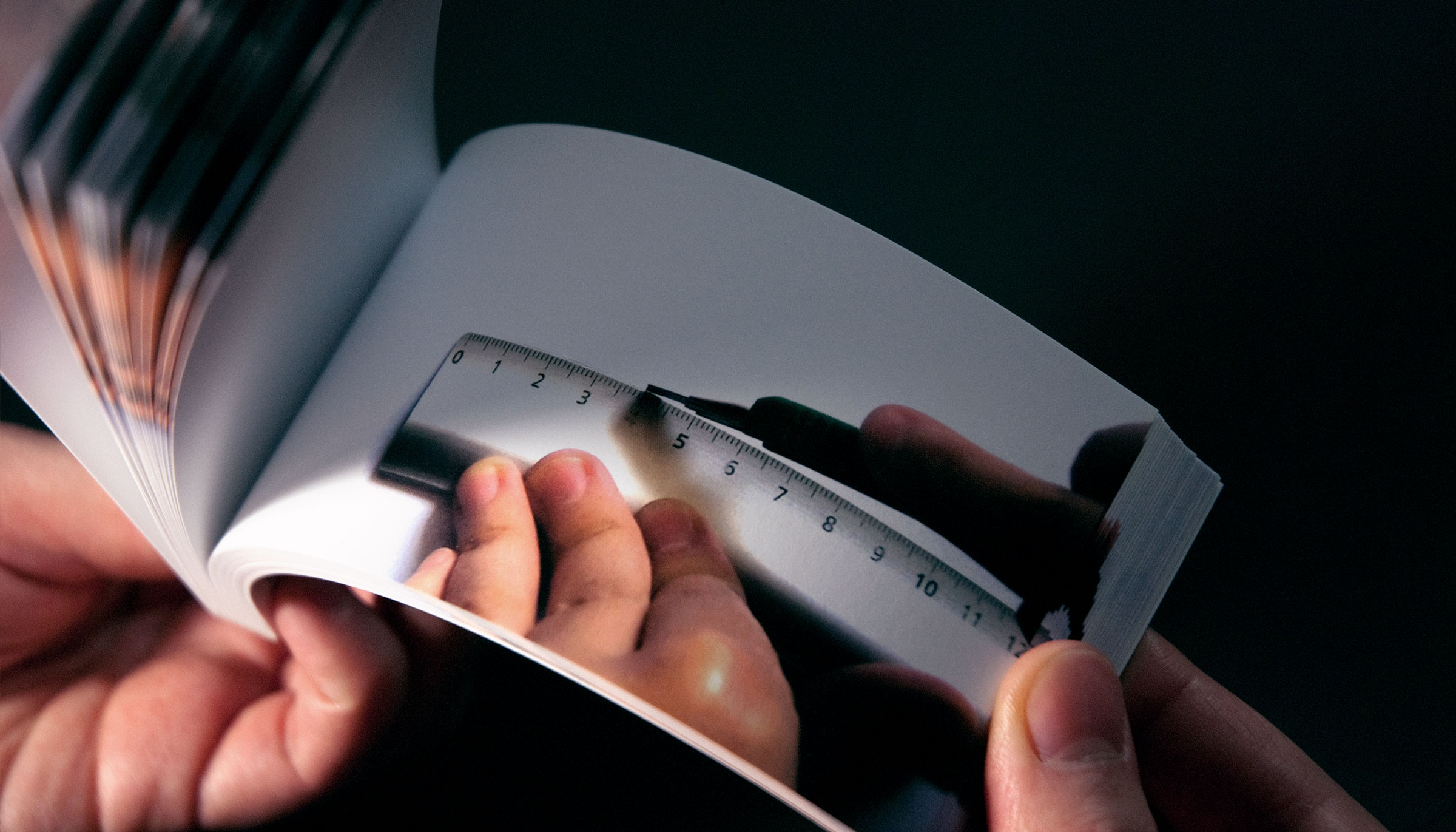
” As we start to skim through the pages, the box cutter seems to slide along the ruler and we think that nothing happens… Suddenly, the pages happens to be cut as if we have held the box cutter in our own hands. Magic of flip book! Artist’s inventiveness! Marie Bocquet did know how to combine imagination, simplicity of an everyday act and the sophistication that makes an object original and unique.
Everybody can make a flip book and that seems to be very simple, but to make a good one requires several skills: first a good idea and then a true sense of animation. It is this combination which makes the flip book work, ensures its fluidity and surprises us.
Artists ‒some of the greatest‒ have been interested in flip books since the second half of the 20th century. Painters, sculptors, draftsmen, photographers and specialists in animation have sometimes taken it like a game among many other works and often without any special presumption. The greatest successes are usually the simplest and this is the case here.
Marie Bocquet is a graphic designer, for example, she had realized a whole work of creation on the word “cut”. It’s all naturally that she may assimilate the flip book technique to offer us this attractive object. Like the American artist Julia Featheringill, she have defaced a very simple situation to produce an artistic work.
This feat had been awarded in the first international flip book competition of Rennes in April 2007.”
Pascal Fouché
O livro está disponível em vídeo no site da artista:
http://www.mariebocquet.com/galerie_flipbook.html
http://www.lendroit.org/catalogue/fiches/248-CUT
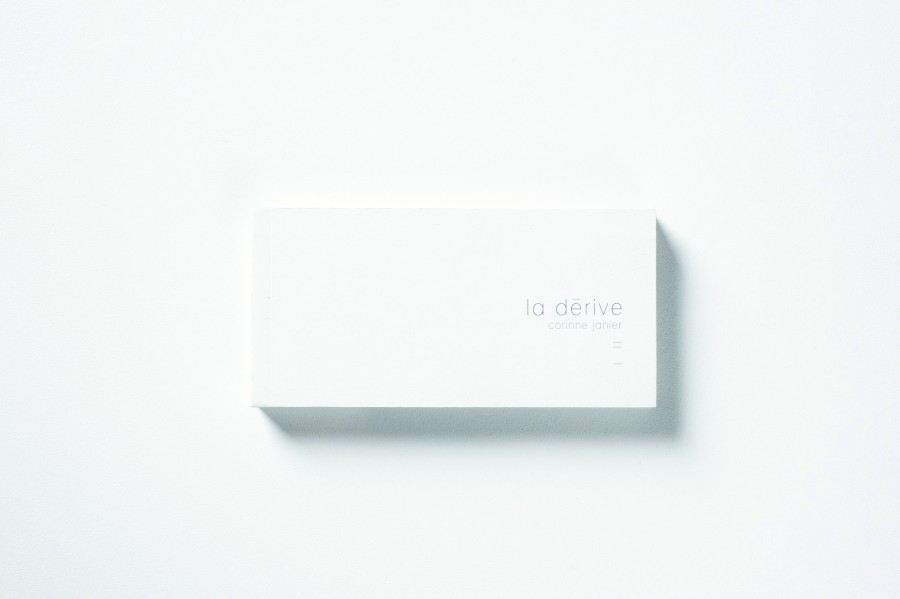
Corinne Janier
La dérive
Rennes, Lendroit, 2001
offset, p&b
12 x 6 cm
180 p.
ISBN 978-2-917427-00-2
“Those who live to the drift are not all poets, but the poets all live adrift”
“At first almost nothing. The convergence of coincidences that I like to think drifting : a lot of old photos, some of which remained at the stage of contact prints, that a friend Clémentine has found on a flea market stall. Then the founded magic in this family images probably passed on the French coast between 1930 and 1940 : kids in vintage swimwear playing on the beach, family portraits together on a rock, prestigious interior views just before the meal, smiles stolen from the deck of a sailboat at the sea… Later then, some of the prints were hypothetically attributed to the German artist Germaine Krull, regularly solicited during this time, i’ve been told, for orders of this type from wealthy French families.
But when I extract from this set, the image of this diver, I wasn’t yet aware of this expertise. At the moment of its discovery, I felt the need to appropriate myself of this photo, which no doubt I would have loved to be the author. From the only print contact (cause I couldn’t find the original negative), I reproduced, expanded and multiplied it.
This body that seemed to have been trimmed to the surface of the this black sea, frozen in the trajectory of its plunge into the ominous silence of a black and white landscape, attracted me and it echoes in my photographic concerns.
First its generic nature : it seemed as if we had wanted to draw a diver above the sea, it would have made this image. Then its disturbing strangeness related to this body that we don’t know the face, in that sea where we can’t see the horizon, to this movement stopped in his tracks whose fall seems latent and inevitable.
The body crosses the water’s surface. The sea opens and the produced shock breaks the silence of this peaceful setting for a summer afternoon. Or maybe not…”
Corinne Janier
Lyon, October 2007
https://www.corinnejaniercolombel.com/edition
http://www.lendroit.org/catalogue/fiches/73-La-derive
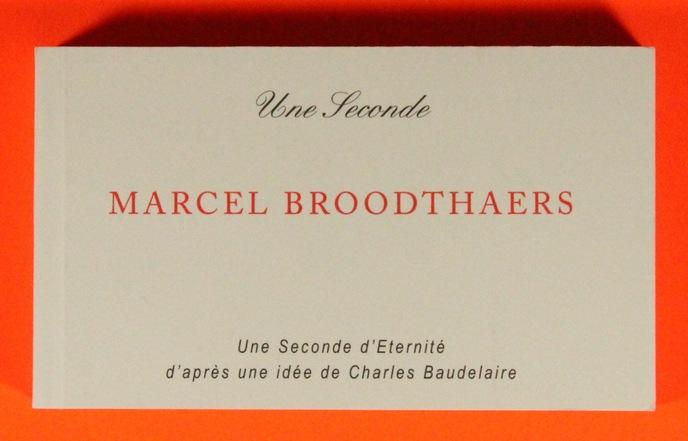
Marcel Broodthaers
Une Seconde d’Éternité
Köln, Koenig Books, 2016
160 p.
12 x 7 cm.
ISBN: 9783863358075
Em 1970, o artista e poeta belga Marcel Broodthaers (1924–1976) criou vários filmes – incluindo “Une Seconde d’Éternité d’après une idée de Charles Baudelaire” – ou “A Second of Eternity According to an Idea of Charles Baudelaire”, na qual ele atualizou as idéias de criatividade e narcisismo dos poetas do século XIX para a era do cinema. Broodthaers criou o filme usando animação, traçando as linhas de sua assinatura em 24 quadros de filme (um por segundo), abrindo o obturador da câmera toda vez que ele mudava ou manipulava a imagem. O artista brinca com a ideia da assinatura: tipicamente a garantia do artista quanto à conclusão e autenticidade do trabalho, aqui a assinatura é notável pela ausência de trabalho que acompanha. Este volume, formatado como um flipbook de bolso, é um companheiro perfeito e serve como interpretação do tão aclamado filme.
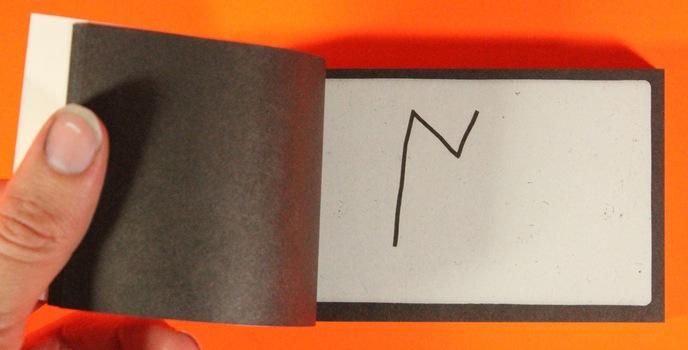


Anne Heyvaert
Plis Pages
Rennes, Incertain Sens, 2015
dos carré cousu collé
offset noir & blanc
[48p.]
26 x 17,5 cm
600 ex.
ISBN 978-2-914291-75-0
Como um flipbook, Anne Heyvaert apresenta em cada página deste livro o desenho de uma folha dobrada ao meio, que se abre gradualmente até o fechamento: trompe l’oeil de um gesto que o leitor efetivamente executa virando as páginas do livro que ele segura em suas mãos.
À la manière d’un flip book, Anne Heyvaert présente, sur chaque page de ce livre, le dessin d’une feuille pliée en deux s’ouvrant progressivement jusqu’à se refermer : trompe-l’œil d’un geste que le lecteur accomplit réellement en tournant les pages du livre qu’il tient entre ses mains.
L’accomplissement du livre est marqué par le pli : si vous prenez une feuille et la pliez en deux, ce simple geste génère, sans que vous n’ayez rien ajouté à la forme première, plate, simple et inerte, une forme profonde, complexe et mouvante.
Michel Melot, Ainsi pense le pli.
“Le pli divise sans séparer et permet, dans un seul mouvement, de passer d’un espace à l’autre et de penser le continu dans le discontinu. La forme du livre fait système. Les dessins insérés entre les pages de ce livre représentent une feuille de papier blanche pliée en deux, s’ouvrant et se refermant de l’autre coté.
La réalisation des dessins est lente et méticuleuse, obsessive et méditative. Ils simulent l’action de passer les pages d’un livre. Entre les ombres portées, apparaissent de nouvelles pages.
Les pages sont blanches, vides, ouvertes sur tous les possibles. Le lecteur s’implique d’une page à l’autre et complète le livre.”Anne Heyvaert, 2015
Noreen Grahame, 1942 – (Austrália)
2015
12 x 3,5 cm
500 exp.
Monsieur Le Président was first published in 1995 as a protest flip book about the announcement by Président Jacque Chirac that he was breaking a three-year moratorium and resuming nuclear testing in French Polynesia in the Pacific Ocean. The only word that appears in the book is ‘non’, which begins small and by the end takes up all the space on the page.
Fonte: grahamegalleries.com.au
Emmett Williams
Soldier
Brest: Zédélé, 2014
[Stuttgart, Hansjörg Mayer ; New York, Something Else Press, 1973]
coleção Reprint
[88 p.]
20 x 15 cm
ISBN. 978-2-915859-38-6
Soldier est un livre de poésie concrète, où le récit est suggéré uniquement par la typographie. Page après page, le livre progresse du même pas que la mort…
Soldier é um livro de poesia concreta, em que a narrativa é evocada pelo uso exclusivo da tipografia. Página após página, a morte avança inexoravelmente através das linhas.
Soldier is a book of concrete poetry, where the narrative is evoked by the sole use of typography. Page after page, death advances inexorably through the lines.

Emmett Williams was an American poet. Between 1957 and 1959 he collaborated as an artist and poet with Daniel Spoerri in the Darmstadt circle of concrete poetry. In the 1960s, Williams was the European coordinator of Fluxus.

Soldier is the 5th book to be published in the Reprint collection curated by Anne Moeglin-Delcroix and Clive Phillpot.
“Entre 1966 e 1970, Emmett Williams (1925-2007) foi o editor, com Dick Higgins, da Something Else Press, que publicou um grande número de livros de artistas ligados ao movimento Fluxus. Um pioneiro dos anos cinquenta de uma nova forma de poesia chamada “poesia concreta”, em referência à arte concreta, em 1967 Emmett Williams montou a primeira coletânea de obras de poetas e artistas internacionais, An Anthology of Concrete Poetry, publicada simultaneamente por Hansjörg Mayer na Europa e Dick Higgins nos Estados Unidos. Ele definiu em sua introdução como poesia “direta”, “usando os elementos semânticos, visuais e fonéticos da língua como matérias-primas.” Em contraste com a expressão subjetiva da poesia tradicional, esta abordagem procurou usar um mínimo de recursos, concentrando-se sobre os processos de composição sistemática baseados na repetição, permutação e desenvolvimento mecânico, regidas por um protocolo pré-estabelecido.
“Between 1966 and 1970, Emmett Williams (1925-2007) was the editor, with Dick Higgins, of Something Else Press, which published a large number of books by artists linked with the Fluxus movement. A pioneer from the Fifties of a new form of poetry called “Concrete Poetry”, in reference to Concrete Art, in 1967 Emmett Williams assembled the first collection of works by international poets and artists, An Anthology of Concrete Poetry, simultaneously published by Hansjörg Mayer in Europe and Dick Higgins in the United States. He defined it in his introduction as “direct” poetry, “using the semantic, visual and phonetic elements of language as raw materials”. In contrast with the subjective expression of traditional poetry, this approach sought to use a minimum of resources, focusing on systematic composition processes based on repetition, permutation and mechanical development, governed by a pre-established protocol.
In 1973, again with Hansjörg Mayer and Something Else Press, Emmett Williams published four long autonomous poems, including SOLDIER, composed the previous year at the California Institute of the Arts, and collected in a single volume entitled A Valentine for Noël. The book was dedicated to his young pregnant wife, Ann Noël, whom he had met in 1968 when she was working for a year as Dick Higgins’ assistant, and who, as director of the graphics workshops at CalArts, helped the artist overcome the technical difficulties of changing over from manuscript to printed poems.
Later, Emmett Williams said: “My first ‘dying’ soldiers poem dates from 1970 during the war in Vietnam.” This first version of SOLDIER is a silkscreen print in red and blue. It is obvious that the later version – a sequence of 40 pages during which the reader sees the three red letters, DIE, gaining one line on each sheet – is visually more striking and politically more effective: by the simplest of means, it makes the inevitable advance of death in the column of soldiers typographically visible. For this re-edition, it also seemed obvious that the publication of the poem in a separate volume restored its implicit function as a flip book. The “playful” aspect present in all Emmett Williams’ works seems to have taken refuge here in the childlike form of these animated books, designed to give the impression of continuous motion. Far from undermining the tragic nature of the subject, the flip book form accentuates the protest against war as a killing machine. A flip book for adults, which remains highly topical.” (Text inserted in the book)
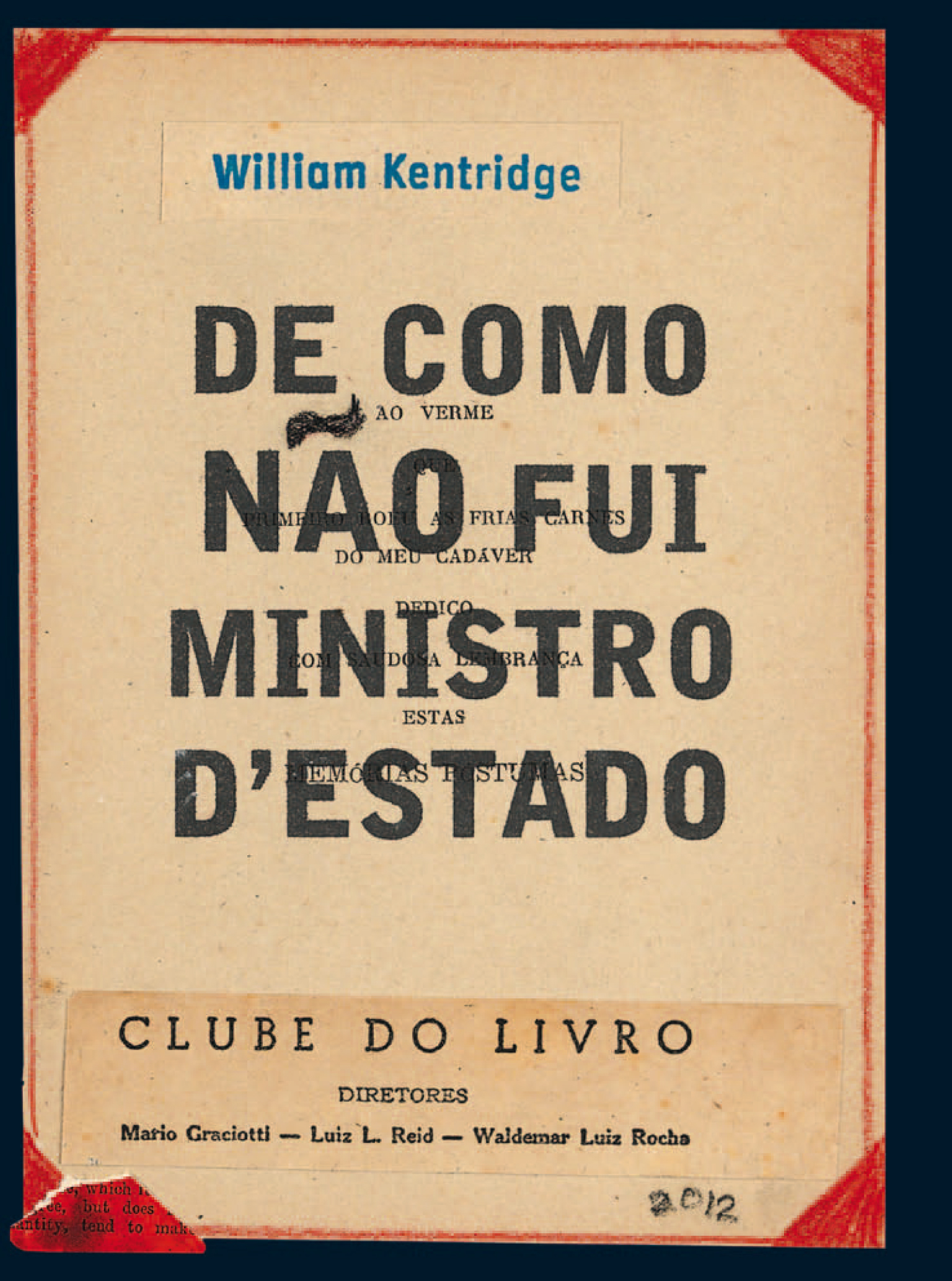
William Kentridge
De Como Não Fui Ministro D’Estado
São Paulo: Pinacoteca/IMS, 2013
17,3 x 13,8 cm
190 p.
O flipbook De como não fui ministro d’estado é uma edição fac-similar da obra especialmente criada por William Kentridge para a exposição brasileira Fortuna. Na publicação, Kentridge faz uma intervenção em uma edição de Memórias póstumas de Brás Cubas, de Machado de Assis, publicada pelo Clube do Livro, em São Paulo, em 1946.
Com desenhos de sua autoria e trechos do livro de Machado, William Kentridge cria uma narrativa que ganha movimento com o trocar de páginas. A publicação é acompanhada por um dvd com um curta-metragem com a animação dessa narrativa.

Sobre o autor
William Kentridge (Johannesburgo, África do Sul, 1955) estudou ciências políticas e estudos africanos na Universidade de Johannesburgo antes de entrar na Johannesburg Art Foundation e se voltar para as artes visuais. Durante esse período, dedicou-se intensamente ao teatro, concebendo e atuando em diversas montagens. Seu interesse pelo teatro e pela ópera perpassa toda sua trajetória e indica o caráter dramático e narrativo de sua produção artística, assim como o seu interesse em sintetizar o desenho, a escultura e o filme em uma única linguagem. Após ter influenciado artistas na África do Sul por mais de dez anos, Kentridge ganhou reconhecimento internacional em meados dos anos 1990. Desde então, seu trabalho tem sido incluído em exposições e performances em museus, galerias e teatros em todo o mundo, como a mostra Documenta, em Kassel, na Alemanha (1997, 2003, 2012), a Bienal de Veneza (1993, 1999, 2005), exposições individuais no moma, de Nova York (1998, 2010), no Museu Albertina, em Viena (2010), no Jeu de Paume, em Paris (2011), no Louvre, em Paris (2010), no Metropolitan Museum of Art, em Nova York (2005), e performances na Metropolitan Opera, em Nova York (2010), e no La Scala, em Milão (2011). Em 2011, Kentridge recebeu o prestigioso Kyoto Prize, em reconhecimento a suas contribuições no campo das artes visuais e da filosofia. No mesmo ano, foi escolhido como membro honorário da American Academy of Arts and Letters e recebeu o título de doutor honoris causa da University of London. Em 2012, apresentou as Charles Eliot Norton Lectures, na Universidade de Harvard, em Cambridge; tornou-se membro da American Philosophical Society, da American Academy of Arts and Sciences; foi nomeado para o Dan David Prize, da Tel-Aviv University; e recebeu o título de Commandeur dans l’Ordre des Arts et des Lettres do Ministério da Cultura e Comunicação da França.